The Historical Museum of Southern Florida presents the history of South Florida and the Caribbean. The museum's permanent exhibit addresses Native American life, the international rivalry for dominance in the region, southward expansion and Seminole displacement, the development of technology and the region's economy, and immigration and tourism to South Florida. Consistent themes include ethnic diversity, immigration, and use of the natural environment.
The museum offers exhibits, summer camps, curriculum-based programs for students, historical site excursions for students, outreach programs for students, evening history programs, family programs, social and ecological history tours for adults, and research library and archive access. The website offers pre-visit materials.
